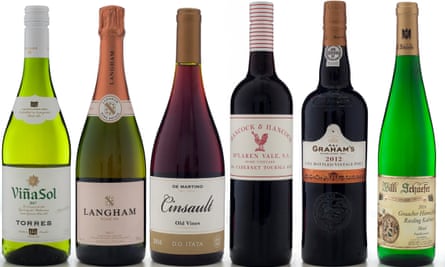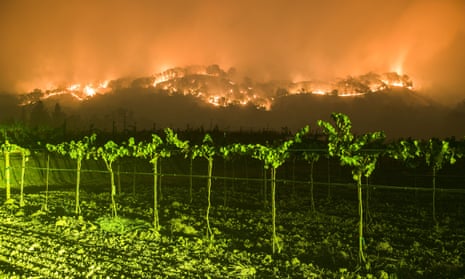One of the ways the British media covers climate change is to treat it as a bit of banter in silly-season items on English wine. This summer’s heatwave was the pretext for an awful lot of these “and finally” moments, in which the tone is unfailingly flippant: never mind the melting Arctic, the shires will take over from Champagne!
The Guardian’s product and service reviews are independent and are in no way influenced by any advertiser or commercial initiative. We will earn a commission from the retailer if you buy something through an affiliate link. Learn more.
Well, hoorah for that. Except, of course, the impact of climate changeon wine isn’t quite as straightforward as a few nice summers and guaranteed bumper vintages in Sussex. What the larky local-radio questions about Bordeaux-on-Thames tend to gloss over is that itwon’t necessarily make the UK, or anywhere, a better place to grow wine. Erratic weather, floods, hurricanes, extreme, unseasonal frost and drought: none of these are friends of the winemaker.
Winemakers are attuned to the minutest changes in the weather – differences that they can, literally, taste in their wines. A line-up of past vintages offers a sensorial record of climatic patterns, and the message sent by those bottles has been troubling the world’s winemakers for years.
With each new record-breaking hot summer, the long-term viability of swathes of the wine world is called into question
On one level, this is purely a question of quality and style. With grapes accumulating high levels of sugar (and therefore potential alcohol when they ferment) much sooner than they used to, as vintages get hotter – and way before the other elements, the tannins and the polyphenols that give wine its complex flavours, are ready – winemakers have a dilemma. They can either harvest much earlier, sacrificing complexity for acceptable alcohol levels, or produce wines with an undrinkable alcoholic force.
With each new record-breaking hot summer and earliest-ever vintage, the long-term viability of whole swathes of the wine world is called into question – grape varieties, the location of vineyards, access to dwindling supplies of water,the ability to produce wines in anything like the same style, quantity and quality. As the great Californian wine producer Randall Grahm put it matter of factly to the New Yorker’s Adam Gopnik earlier this year: “It’s everywhere. Burgundy may be fucked. The northern Rhône is partly fucked … the southern Rhône is fucked.”
Grahm’s ambitious latest project is near Santa Cruz, an attempt to breed a new grape variety that can cope with the current Californian climate, one capable of being dry farmed (without irrigation) and to withstand heat. This is urgent, serious business in a part of the world where wildfires have destroyed thousands of acres of vineyards, and taken many lives and livelihoods, in the past two years – and where nobody is treating climate change as a funny sign-off on the news.

Torres Viña Sol, Penedès, Spain 2017
From £6, Asda, Tesco, Sainsbury’s
The vast Torres operation was quick to identify the challenges posed by climate change, investing millions in research into carbon capture, water efficiency and relocation of its vineyards to protect the future of wines such as this ever-green, bargain dry white.
Langham Estate Rosé Brut, Dorset, England NV
From £28, leaandsandeman.co.uk; langhamwine.co.uk
There’s no doubt that changes in the English climate so far have been helpful to sparkling winemakers, enabling them to ripen pinot noir, chardonnay and pinot meunier consistently and make such outstandingly balanced nuanced, berry-scented wines as this.
De Martino Old-Vine Cinsault, Itata, Chile 2016
£11.99, Waitrose
Irrigation of vines has been seen as essential in many warm-climate regions, but as the resource has become increasingly precious, many are looking to dry-farm. This racy, crunchy, redcurrant-tangy red from old cinsault vines in southern Chile is proof of the possibilities.
Hancock & Hancock Cabernet/Touriga, McLaren Vale, Australia 2015
From £12.75, farehamwinecellar.co.uk; ampswinemerchants.co.uk; cambridgwine.com
In south Australia, many producers are responding to rising temperatures by switching to grapes of southern-European heritage, leading, in this blend of France’s cabernet and Portugal’s touriga, to a deliciously violet-scented, darkly fruited, chunky red.
Graham’s Late Bottled Vintage Port, Douro, Portugal 2012
From £10, Morrisons, Sainsbury’s, Asda, Tesco
Port producer Paul Symington spoke gloomily of “the existential threat” posed by climate change to wine production in the Douro Valley at a recent conference, making his family’s glossy and sumptuous Graham’s LBV now officially an endangered species.
Willi Schaefer Graacher Himmelreich Riesling Kabinett, Mosel, Germany 2016
£19.95, tanners-wines.co.uk
As in England, changes in the climate have had some positive effects in cool, northerly Germany, with fewer bad (cold, wet) vintages than in the past. Whether the country will still be capable of producing such intricate, lacy, delicate riesling as this in 2050 is a whole other question, however.

Comments (…)
Sign in or create your Guardian account to join the discussion